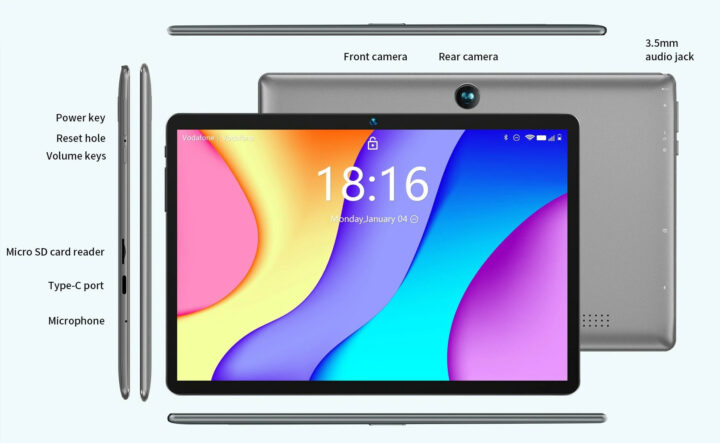Back in March, Rockchip showcased some tablets powered by the new 2.0 GHz Rockchip RK3562 quad-core Cortex-A53 processor, and now commercial Android 13 tablets based on the SoC are starting to show up with models such as BMAX MaxPad I9 PLUS and UMIDIGI G1.
Both tablets have pretty much the same specifications with a 10.1-inch IPS display with 1280×800 resolution, 8GB RAM, 64GB eMMC flash, front-facing and rear cameras, and a few ports such as USB-C and an audio jack.
For reference, I’ll just go through BMAX MaxPad i9 PLUS tablet specifications:
- SoC – Rockchip RK3562
- CPU – Quad-core Arm Cortex-A53 processor @ up to 2.0 GHz
- GPU – Arm Mali-G52 EE with support for OpenGL ES 3.2, Vulkan 1.1, OpenCL 2.0
- AI accelerator – 1 TOPS NPU
- VPU – 4Kp30 video decoding, 1080p60 video encoding
- Memory – 8GB RAM (4GB RAM + 4GB Expansion) – CNXSoft: I’m not sure what that means, hopefully, it’s not 4GB physical RAM and 4GB swap…
- Storage – 64GB eMMC flash and microSD card socket
- Display – 10.1-inch IPS display with 1280×800 resolution, 10-point capacitive touch
- Cameras
- 5.0 MP rear camera with autofocus
- 2.0 MP front-facing camera
- Audio – 3.5mm audio jack, built-in microphone and stereo speaker
- Wireless – WiFi 6 and Bluetooth 5.0
- USB – 1x USB Type-C port for charging
- Misc, Power and volume keys; reset pinhole
- Battery – 6,000 mAh battery good for up to 5 hours of video playback
- Dimensions – 10.1 mm thick
- Weight – 490 grams
While those are still clearly entry-level tablets, the new RK3562 processor is said to deliver 127% higher performance than similar tablets based on the previous generation Rockchip RK3328 processor according the the tablet’s Antutu score.
Both Rockchip RK3562-based Android 13 tablets are available now with the BMAX MaxPad I9 Plus going for $67.05 on Aliexpress, and the UMIDIGI G1 can be purchased on either Amazon or Aliexpress for and up.
Via AndroidPC.es

Jean-Luc started CNX Software in 2010 as a part-time endeavor, before quitting his job as a software engineering manager, and starting to write daily news, and reviews full time later in 2011.
Support CNX Software! Donate via cryptocurrencies, become a Patron on Patreon, or purchase goods on Amazon or Aliexpress






